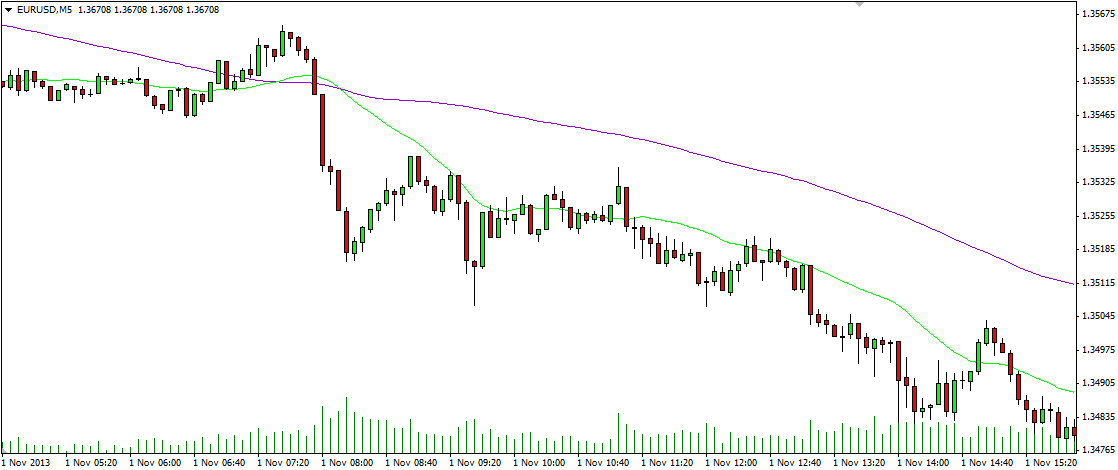Purchasing Managers Index (PMI)
This lesson will cover the following
- Description of the Purchasing Managers Index
- How traders interpret it
Purchasing Managers Index in general
The Purchasing Managers Index (PMI) is a compound and timely indicator, providing clues regarding sentiment in sectors of the economy such as manufacturing, services and construction. This indicator is usually released on the first business day of each month following the survey month by the Institute for Supply Management (ISM), a non-profit organization with more than 40 000 members, engaged in the supply management and purchasing professions.
The PMI is a composite index comprised of five “sub-indexes”, which usually correspond to surveys, encompassing more than 400 purchasing managers operating within the country, chosen for their geographic and industry diversification benefits. These five sub-indicators are given a weighting, as follows:
– Production level 0.25
– New orders from customers 0.30
– Supplier deliveries timing 0.15
– Inventories 0.10
– Employment level 0.20
As the index represents a survey, results of this survey are usually diffused into only three options. Managers, participating in the survey, can either respond with “better”, “same”, or “worse” to the questions about the industry, in which they operate. The value of the index is calculated as follows:
PMI = (P1*1) + (P2*0.5) + (P3*0), where
P1 is the percentage number of responds that reported an improvement,
P2 is the percentage number of responds that reported no change in conditions,
P3 is the percentage number of responds that reported worse conditions.
The resulting PMI value is measured from 0 to 100. If the index shows a value of 100.0, this means that 100% of the respondents reported an improvement in conditions. If the index shows a value of 0, this means that 100% of the respondents reported a deterioration in conditions. If 100% of the respondents saw no change in conditions, then the index will show a reading of 50.0.
The Institute for Supply Management publishes this indicator for the United States. Similar indicators for countries in the Euro zone and the United Kingdom, for example, are released by Markit Economics research group.
How do traders read the Purchasing Managers Index?
When a fundamental analyst examines a PMI, the key level (value), which he/she takes into consideration is 50.0. A reading of 50.0 or higher is considered as an indication that the industry (sector) is expanding. In case manufacturing sector is expanding, overall economic activity should be expanding as well. Therefore, the PMI is considered also as an indicator providing clues for nations GDP levels in the future. Many economists will adjust their GDP forecasts, after they have read the PMI report.
Another reading of utmost importance is 42.0. If a PMI shows a reading higher than 42.0 over time, this is usually indicative for economic expansion (growing GDP figure). The different values between 42.0 and 50.0 suggest how strong this expansion is. If the PMI reading falls below 42.0, this means that recession (economic contraction) could be on the horizon.
The rate of change from month to month is crucial. This is the factor, which causes influence upon currencies of countries, when they publish data concerning manufacturing or services PMI.
If a report states that manufacturing PMI of a given nation shows a reading of, say 50.5 during this month (which speaks of expanding activity in the sector of manufacturing), after a month ago the indicator reached a value of, say 55.6, then such PMI performance would probably not be seen favorably by market players, especially if economy of that same nation had been demonstrating signs of resilient growth recently. Thus, traders would tend to sell (short) the currency of that nation. In case we are referring to manufacturing PMI for Germany, then traders would sell EUR/USD pair (selling the euro and buying the US dollar, as we have already discussed).
Example
Source: MetaTrader 4 by MetaQuotes Software Corp.
On the chart above we can see how EUR/USD reacts to the announcement of the manufacturing PMI for the United States at 14:00 GMT on November 1st. The report by the ISM showed that the index advanced to a value of 56.4 in the month of October, which exceeded expectations of a reading of 55.1. The three red candles starting from 14:00 GMT visualize a movement of about 15-20 pips in EUR/USD cross (traders obviously supported the greenback after the upbeat result).
